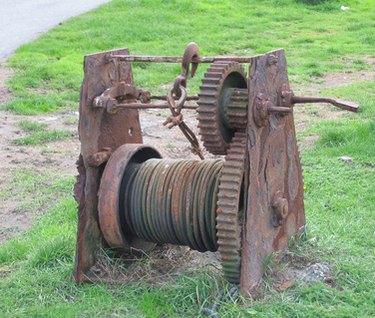
Some traditional tools can be used to lift and transport heavy stones with relative ease. Even if you don't have electricity or a motor-powered vehicle with which to power the haul, there are still ways to complete this task. Everyone owning a home or business at a location where moving large stones may be necessary should have some basic knowledge and tool selection with which to move them.
Pry Bar
Video of the Day
A pry bar is shaped like a very large tire iron. It has a tapered end that fits beneath a large rock. A brick or piece of scrap wood is placed behind the bar so the bar is wedged between the brick and the large rock. When weight is applied to the other end, the rock is lifted free of its position. This simple tool is especially useful for getting large rocks out of the ground so that they may be rolled, wedged or pulled to a new position. The basics of leverage are behind the bars design, it allows just about anyone to move very large stones. Pry bars are about 4 feet in length and between 16 and 18 lbs.
Video of the Day
Bobcat
A bobcat is a small compact tractor. The cab is just large enough to seat only the driver. This piece of machinery is very convenient for folks needing to routinely move heavy objects such as stones. Because of the small size, this tractor can make tight turns and get into smaller spaces than a traditional tractor. Hitches and loaders are easily installed on the front and back of the machine to make moving anything easier. Hydraulics ease the turbulence, making this bobcat a smooth ride.
Winch
Several types of winches are sold. These tools create leverage, allowing people to move exceptionally heavy objects. They usually consist of a cable. One end of the cable is attached to the stone; the other is secured to a nonmoving object such as a tree. Between these two ends is a metal body with a lever. When the lever is cranked, the cable is pulled through a serious of wheels within the metal body and then wound. The shortening of the cable coupled with the leverage created by the inner workings of the winch pull heavy objects free of their position with ease. Cable winches will wind continuously, allowing the use to install any length of cable they prefer. Usually a nylon net or heavy-duty tarp is wrapped around the stone to prevent it from coming lose.
Bars
If you have very few tools to work with, this homemade contraption may do the trick. Iron bars can be utilized as tracks of sort to get a heavy object from one place to another. The iron bars are placed on the ground parallel to each other, and the stone is loaded onto this makeshift "track" using a pry bar. The stone will slide along the iron bars as if it were on a conveyor belt. When you near the end of the bar track, you will need to bring the back bars around and place them in front of the stone to continue the track. Logs can be substituted instead of the bars for this technique, and stone may be rolled along the track rather than slid.